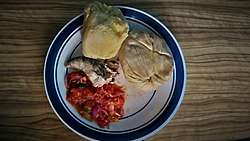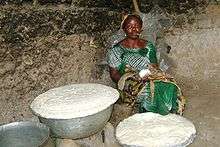Kenkey
Kenkey (also known as kormi,otim,kooboo or dorkunu) is a staple dish similar to sourdough dumpling from the Ga and Fante-inhabited regions of West Africa, usually served with pepper sauce and fried fish or soup, stew.
 Kenkey and ground pepper with sardine | |
| Alternative names | kɔmi pronounced (kormi), |
|---|---|
| Type | Dumpling |
| Place of origin | Ghana |
| Main ingredients | Ground corn |

Variations
Areas where kenkey is eaten are Ghana, eastern Côte d'Ivoire, Togo, western Benin, Guyana, and Jamaica. It is usually made from ground corn (maize), like sadza and ugali. It is popularly known as kɔmi pronounced (kormi) by the Gas or dokono by the Asante in Ghana. It is also known in Jamaica as dokunoo, dokono, dokunu, blue drawers, and tie-a-leaf. In Mexico, there is a version called "Tamale". Kenkey can also be found in an area of Northern Ghana called "Tamale". In Guyana, it is called konkee.[1] In Trinidad it is called "paime" (pronounced pay-me) and differs in that it does not contain plantain but may include pumpkin and coconut. In the cuisine of the Caribbean, it is made with cornmeal, plantain, green banana, sweet potato (Asante and Jamaican version, which came from the Asante version) or cassava, wrapped in banana leaves. The food is derived from African cooking traditions.[2][3]

Unlike ugali, making kenkey involves letting the maize ferment before cooking. Therefore, preparation takes a few days in order to let the dough ferment. Corn meal is mixed with cornstarch and water is added until a smooth and consistent dough is obtained. It is covered and left in a warm place for the fermentation to take place.[1] After fermentation, the kenkey is partially cooked, wrapped in banana leaves, corn husks, or foil, and steamed.[4] There are several versions of kenkey, such as Ga and Fante kenkey. The Ga kenkey is more common in most parts of Ghana.
References
- "Ghana: Kenkey". 196 flavors. 2019-06-21. Retrieved 2020-06-04.
- Jamaican Cooking: 140 Roadside and Homestyle Recipes.
- "Regional Dishes". touringghana. Archived from the original on 10 August 2013. Retrieved 9 August 2013.
- "KENKEY". Ghanaweb. Retrieved 9 August 2013.
External links
- Phil Bartle, "Kwasi Bruni; Corn and the Europeans", VCN.org.
- "West Africa Recipe - Cooking Kenkey". West Africa Secondary School, Accra, Ghana. PBS Kids.
- "Questions and Answers > Food products > What is kenkey and how is it made?". Food-info.net. Wageningen University, The Netherlands.
- Fran Osseo-Asare (March 28, 2007). "Ghana-style Kenkey". Betumi.com.
- "Studies on kenkey : a food product made from corn in Ghana"
- "Paime: a traditional dessert", Daily Express (Trinidad & Tobago), 3 September 2010.
- Acceleration of the fermentation of kenkey, an indigenous fermented maize food of Ghana.[1]
- Microbiological and Aromatic Characteristics of Fermented Maize Doughs for Kenkey Production in Ghana.[2]
- Nutrient Content and Survival of Selected Pathogenic Bacteria in Kenkey Used as a Weaning Food in Ghana.[3]
See also
- Cuisine of Ghana
- Cuisine of Jamaica
- List of African dishes
- List of dumplings
- Tamale
- Nout, M. J. R.; Kok, B.; Vela, E.; Nche, P. F.; Rombouts, F. M. (1995-01-01). "Acceleration of the fermentation of kenkey, an indigenous fermented maize food of Ghana". Food Research International. 28 (6): 599–604. doi:10.1016/0963-9969(95)00059-3. ISSN 0963-9969.
- M, Halm; A, Lillie; Ak, Sørensen; M, Jakobsen (July 1993). "Microbiological and Aromatic Characteristics of Fermented Maize Doughs for Kenkey Production in Ghana". International journal of food microbiology. PMID 8398627. Retrieved 2020-06-06.
- A, Annan-Prah; Ja, Agyeman (1997-04-30). "Nutrient Content and Survival of Selected Pathogenic Bacteria in Kenkey Used as a Weaning Food in Ghana". Acta tropica. PMID 9140512. Retrieved 2020-06-06.